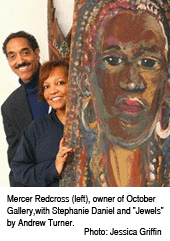Excerpt from Philadelphia Daily News
Nov. 6, 2006
By Robert Strauss
Black (art) is Beautiful
African-American works highlighted at Liacouras Center this weekend
Stephanie Daniel is helping promote the 21st Annual October Gallery Philadelphia International Art Expo, Friday through Sunday at the Liacouras Center at Temple University, an event expected to attract more than 40,000 current and potential collectors of art of all kinds made by African-Americans.
To accompany the expo, Redcross and the October Gallery have produced “Connecting People with Contemporary African American Art,” a 500-page, full-color coffee-table book chronicling the rise of art and art collecting by African-Americans.
Daniel, for her part, thinks that rise came not from a push in formal art appreciation but from a less highfalutin form – the TV shows “Good Times” and “The Cosby Show.”
‘Image of sophistication’
The main character on “Good Times,” which ran from 1974-79, J.J. Evans, played by Jimmy Walker, was an artist, but the art displayed on the show was mainly done by a seasoned painter, Ernie Barnes.
Then, from 1984-92, sets for “The Cosby Show” often had art of all types hanging on the walls in the family house.
“It became mainstream in African-American homes after that to have something on the wall, even if it was just a $15 poster,” said Daniel. “It was an image of sophistication we suddenly wanted to have.”
Still, people who wanted to buy original African-American art, particularly in Philadelphia, would have had a little trouble back in those days.
“Three months after going into business nearly 40 years ago, a gallery owner called to welcome me to the community,” said Sande Webster, whose eponymous gallery is at 20th and Walnut streets. “She said she had heard I was going to display black artists, and she warned me that if I did and black people would come to the gallery, then white people wouldn’t and I would go out of business.”
Webster said she ignored the advice and that when she has shown black artists – her gallery now is featuring Moe Brooker, an impressionist – she has had no problem attracting buyers.
“I would defy anyone coming in, year after year, to tell me what works were done by white artists and which ones were done by black artists,” said Webster. “I’m of the opinion that while art is surely the sum of the artist’s experience, it isn’t ‘black’ or ‘white,’ per se.


